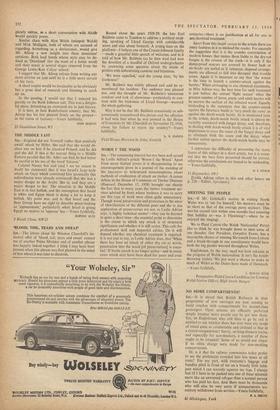WORM I' THE WOOD Sta.—The consuming interest has not been
well served by Leslie Adrian's article 'Worm i' the WOod.' Apart from many factual errors it is disappointing to see encouragement given in a journal of the standing of the Spectator to widespread misconceptions about methods of eradication of attack on timber. A recent debate in the House of Commons on Timber Diseases (Hansard, December 17, 1958) brought out clearly the fact that in many cases the timber treatment ser- vices advised by firms whose business it was to carry out this type of work were often quite unnecessary. Though wood preservation and protection in the sense of identification of the different pests and the in situ application of preservatives are not, as Leslie Adrian says, 'a highly technical matter'—they can be learned in quite a short time—the essential point to determine is the extent to which any attack is of structural significance and whether it is still active. This calls for professional skill and impartial advice. On it will depend whether any chemical treatment is required. It is not true to say, as Leslie Adrian does, that 'When there has been an attack of either dry rot or worm, penetration into the wood [of preservatives] is essen- tial.' If beetle attack is no longer active—and in many cases attack may have been dead for years and even centuries—there is no justification at all for any in situ chemical treatment.
Apart from this major caveat to the article there are many features in it to mislead the reader. For example the suggestion that it is the sounder construction of modern houses that makes them liable to the dry-rot fungus is the reverse of the truth—it is only if the damp-proof courses are covered by flower beds or air-bricks are sealed or if rainwater disposal arrange- ments are allowed to fall into disrepair that trouble arises. Again it is incorrect to say that 'the winter is the time to launch a counter-attack against the beetles.' When envisaging in situ chemical treatments, as Miss Adrian was, the best time for such treatment is just before the annual 'flight season' when the greatest number of larvie, pupa:, and adult beetles will be nearest the surface of the infected wood. Equally misleading is the statement that the counter-attack against the furniture beetle is `very much the same' as against the death-watch beetle. As is mentioned later in the article, death-watch beetle attack is almost in- variably associated with fungal decay, and, therefore, in dealing with death-watch beetle attack it is of vital importance to trace the cause of the fungal decay and to eliminate both the cause and the decay, when further action against the death-watch beetle may be unnecessary.
I appreciate the difficulty of presenting the many facets of this subject in a short article, but it is essen- tial that the bare facts presented should be correct, otherwise the conclusions are bound to be misleading. —Yours faithfully, 11 Haymarket, SW 1 [Leslie Adrian refers to this and other letters on p. 228.—Editor, Spectator.]






































 Previous page
Previous page